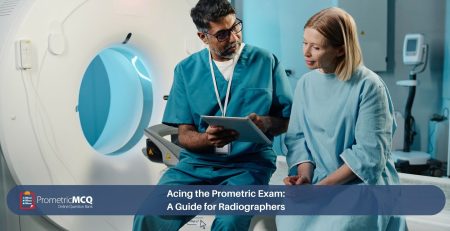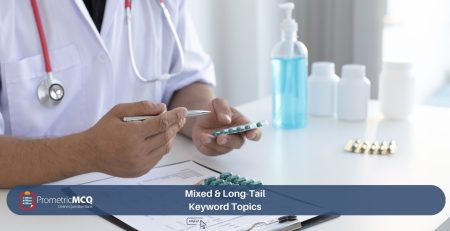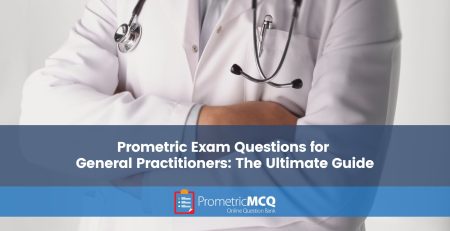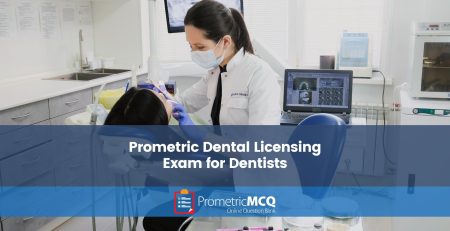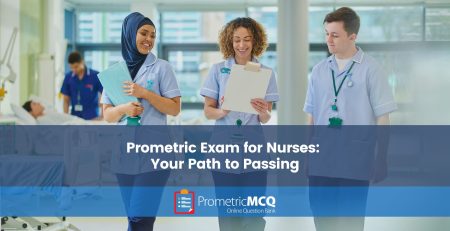
Free Prometric Exam Questions for All Medical Specs
fatima@prometricmcq.com2025-09-29T23:34:30+00:00Table of Contents
ToggleFree Prometric Exam Questions for All Medical Specs (2025)
The journey to obtaining a professional license to practice in the Gulf’s advanced healthcare systems is a challenging yet rewarding endeavor. For every healthcare professional—whether a doctor, nurse, dentist, pharmacist, or allied health specialist—the Prometric licensing exam stands as the critical benchmark of competency. These exams, administered for authorities like the DHA, MOH, SCFHS, and QCHP, are designed to test not just what you know, but how you think and apply your knowledge in realistic clinical situations.
While the specific content varies widely, the universal language of these exams is the case-based Multiple-Choice Question (MCQ). Mastering the art of dissecting these questions is the single most important skill for success. The best way to develop this skill is through practice. Engaging with high-quality, exam-style questions allows you to identify your knowledge gaps, perfect your time management, and build the confidence needed to perform under pressure. Access to free, high-quality sample questions is an invaluable starting point for any candidate’s preparation journey.
This ultimate 2025 guide has been created as a comprehensive, multi-specialty resource, providing a free collection of high-yield Prometric exam questions for all major healthcare professions. Each question comes with a detailed, evidence-based rationale that illuminates the critical thinking behind the correct answer. This is more than just a list of questions; it is a strategic training tool, complete with a robust 10-point FAQ section to guide your entire preparation process. This is your first step to understanding the exam and building a winning study strategy.
Key Takeaways for All Prometric Exams
- It’s a Test of Application, Not Memorization: All Prometric exams focus on your ability to apply knowledge to clinical scenarios.
- Patient Safety is the Universal Priority: No matter your specialty, the safest option is almost always the correct one.
- Time Management is a Learned Skill: The strict time limits require a practiced, strategic approach to answering questions.
- Learn from Every Question: The deepest learning comes from analyzing the rationales for both correct and incorrect answers.
- A Universal Format: All exams are CBTs with MCQs and no negative marking, making a consistent preparation strategy possible.
Section 1: Prometric Questions for Physicians
The exams for physicians test a wide range of clinical knowledge, from broad primary care to deep specialty-specific topics.
Question 1: General Practitioner (GP)
A 60-year-old male with a 10-year history of type 2 diabetes and hypertension presents for a routine check-up. His medications include metformin, lisinopril, and atorvastatin. His blood pressure is 135/85 mmHg and his HbA1c is 7.2%. A recent urine test shows a urine albumin-to-creatinine ratio (UACR) of 150 mg/g. According to the latest guidelines, what is the most appropriate next step to manage his newly discovered albuminuria?
- Increase the dose of lisinopril.
- Add a diuretic like hydrochlorothiazide.
- Initiate an SGLT-2 inhibitor like empagliflozin.
- Advise the patient to further restrict dietary protein.
Correct Answer: C (Initiate an SGLT-2 inhibitor like empagliflozin.)
Rationale: This question tests your knowledge of the current, guideline-based management of diabetic kidney disease. The patient has persistent albuminuria (UACR > 30 mg/g) despite being on an ACE inhibitor (lisinopril). Major international guidelines (like those from KDIGO and the ADA) now strongly recommend the addition of an SGLT-2 inhibitor for patients with type 2 diabetes and diabetic kidney disease, as these agents have been proven to slow the progression of nephropathy and reduce cardiovascular risk, independent of their glucose-lowering effect. For comprehensive GP preparation, a dedicated bank of General Practitioner MCQs is essential.
Why other options are incorrect:
A: While maximizing the ACE inhibitor dose is important, the addition of an SGLT-2 inhibitor is the specific, guideline-recommended next step for its renal-protective benefits.
B: A diuretic would help with blood pressure control but does not offer the specific renal protection that an SGLT-2 inhibitor does in this context.
D: Severe protein restriction is no longer recommended and is not the primary intervention.
Section 2: Prometric Questions for Nurses
Nursing exams are heavily focused on patient safety, prioritization, and the application of the nursing process.
Question 2: Nursing (Prioritization)
A nurse is caring for four patients on a cardiac unit. Which patient requires the nurse’s immediate attention?
- A patient with stable angina who is reporting 3/10 chest pain after walking to the bathroom.
- A patient with heart failure who has 2+ pitting edema in the lower extremities.
- A patient receiving a blood transfusion who is now complaining of lower back pain and has a temperature of 38.5°C (101.3°F).
- A patient who is 2 days post-cardiac catheterization and is ready for discharge teaching.
Correct Answer: C
Rationale: The patient receiving the blood transfusion is exhibiting classic signs of an acute hemolytic transfusion reaction, which is a life-threatening emergency. The combination of fever, chills, and flank/back pain is a red flag. The nurse’s immediate actions should be to stop the transfusion, maintain IV access with normal saline, notify the physician and blood bank, and closely monitor vital signs. This is a critical safety event that takes priority over all other situations described. For more practice, review our Saudi Prometric exam questions for nurses.
Why other options are incorrect:
A: Exertional pain in a patient with stable angina is an expected finding and should be managed, but it is not an acute emergency.
B: 2+ pitting edema is a common and chronic finding in heart failure patients and does not represent an acute change.
D: Discharge teaching is an important but non-urgent task.
Section 3: Prometric Questions for Dentists
Dental exams require strong diagnostic skills, particularly in interpreting clinical signs and radiographs.
Question 3: Dentistry (Oral Surgery)
A 25-year-old healthy male patient is scheduled for the extraction of a symptomatic, non-restorable mandibular right first molar. He has no known drug allergies. According to the American Heart Association (AHA) guidelines, is antibiotic prophylaxis indicated for this patient to prevent infective endocarditis?
- Yes, amoxicillin 2g should be given 1 hour before the procedure.
- Yes, clindamycin 600mg should be given 1 hour before the procedure.
- No, antibiotic prophylaxis is not indicated for this patient and procedure.
- No, but post-operative antibiotics are recommended for 5 days.
Correct Answer: C
Rationale: This question tests your knowledge of the current, strict guidelines for antibiotic prophylaxis. The latest AHA guidelines have significantly narrowed the indications for prophylaxis. It is now only recommended for patients with the highest risk of adverse outcomes from endocarditis, including those with prosthetic cardiac valves, a history of previous infective endocarditis, certain congenital heart diseases, and cardiac transplant recipients who develop valvulopathy. For a healthy patient undergoing a routine dental extraction, antibiotic prophylaxis is explicitly not recommended. This is a crucial point in preventing unnecessary antibiotic use and resistance. For more practice, a dedicated bank of SDLE questions is vital.
Why other options are incorrect:
A & B: These describe appropriate prophylactic regimens but are not indicated for this specific patient.
D: Post-operative antibiotics are only indicated if there is an active infection, not for routine extraction.
Section 4: Prometric Questions for Pharmacists
Pharmacy exams are a rigorous test of clinical therapeutics, calculations, and pharmacy practice.
Question 4: Pharmacy (Calculations)
How many milliliters of a 70% w/v solution should be mixed with a 20% w/v solution to prepare 500 mL of a 40% w/v solution?
- 100 mL of the 70% solution
- 200 mL of the 70% solution
- 250 mL of the 70% solution
- 300 mL of the 70% solution
Correct Answer: B (200 mL of the 70% solution)
Rationale: This is a classic alligation problem that can be solved with a simple grid.
1. Place the desired concentration in the center: 40%.
2. Place the higher concentration (70%) in the top left and the lower concentration (20%) in the bottom left.
3. Subtract diagonally: 70 – 40 = 30 parts (of the 20% solution). 40 – 20 = 20 parts (of the 70% solution).
4. The total parts required are 30 + 20 = 50 parts.
5. The proportion of the 70% solution needed is 20 parts out of 50 total parts.
6. Calculate the volume needed: (20 / 50) * 500 mL = 200 mL. You would also need 300 mL of the 20% solution. A full bank of Pharmacy MCQs is the best way to master these skills.
Frequently Asked Questions (FAQs) for All Prometric Exam Takers
Your original, valid passport. The name on your passport must be an exact match to your exam registration. This is a non-negotiable requirement at all Prometric centers.
All exams are officially graded as Pass/Fail. The unofficial passing threshold for most generalist exams (GP, Nurse, Pharmacist) is around 60%, while for specialist exams it is higher, around 65-70%. Aiming for 70-75% on practice tests provides a safe buffer.
It is a computer-based test (CBT) composed entirely of multiple-choice questions. There is no negative marking. The number of questions and duration vary by specialty but typically range from 100-300 questions over 2-6 hours.
Adopt a multi-pass strategy. On your first pass, answer all the easy questions you know immediately. Flag the harder questions and return to them on a second pass. This builds momentum and ensures you don’t miss easy points. Practice this strategy during your mock exams.
Yes, absolutely. The clinical content for all exams (DHA, MOH, SCFHS, QCHP, etc.) is based on the latest international, evidence-based guidelines from major global health bodies. For broad medical standards, resources from the World Health Organization (WHO) are a good reference.
Primary Source Verification (PSV) by DataFlow is a mandatory credentialing check. It is separate from the exam but required for your license. They verify your educational and professional documents directly from the source. It’s best to start this process early to avoid delays in getting your license.
A high-quality, comprehensive question bank (QBank) that is specific to your profession and the exam you are taking is the single most effective tool. Active learning by solving thousands of MCQs is superior to passive reading.
Most health authorities allow three to four attempts to pass the licensing exam, with a mandatory waiting period between each attempt. Always check the specific regulations for your health authority.
No. This is a common mistake that increases anxiety and fatigue. The final 24-48 hours should be dedicated to light review and, most importantly, rest and relaxation to ensure your brain is performing at its peak on exam day.
Finding a reliable source of practice questions is key. A comprehensive platform that offers dedicated QBanks for a wide variety of medical specializations is your best asset. You can browse a complete list on our MCQs Packages page.
Conclusion: The Universal Path to a Prometric Pass
The Prometric licensing exams, while specific in their content, share a universal language of clinical reasoning and patient safety. This collection of free sample questions demonstrates the level of application required to succeed. By understanding the exam’s structure, focusing on high-yield topics within your specialty, and committing to a rigorous preparation schedule centered on high-quality MCQ practice, you can confidently meet the challenge. Passing your Prometric exam is the definitive step toward a rewarding healthcare career in the dynamic and ever-growing Gulf region.
Ready to Move from Sample Questions to Full Preparation?
Our premier question banks are filled with thousands of high-yield clinical scenarios, detailed rationales, and full-length simulated exams designed to cover the entire syllabus for your specialty and guarantee your success.

